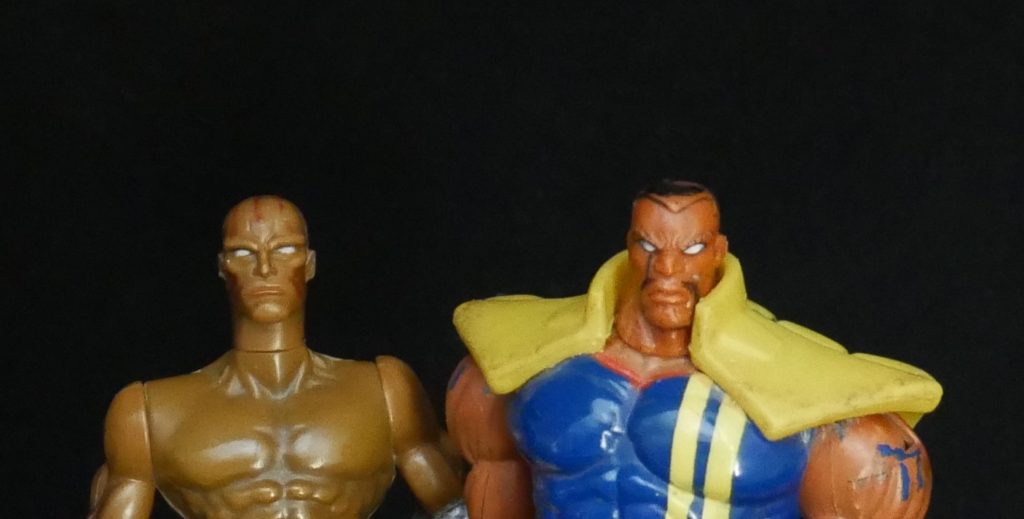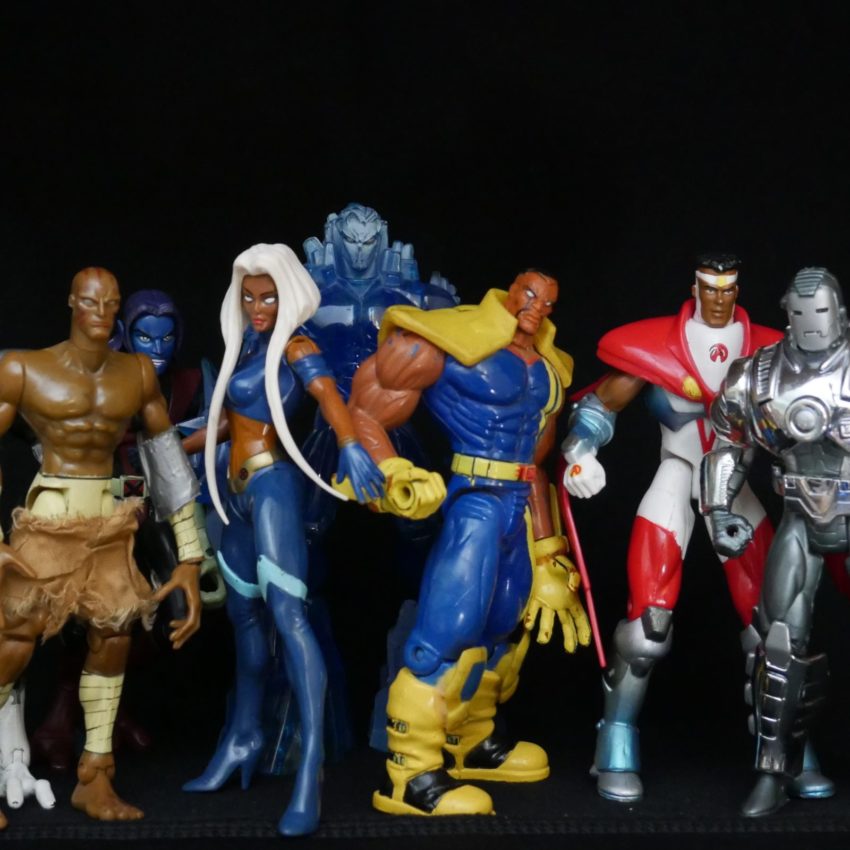In the summer of 2020, my nephew was staying with me for a couple months, and he wanted us to play with my old action figures that my brothers and I had kept from our childhood. I was able to get him to take a liking toward a couple of my favorite toys (Nightcrawler and Iceman), but I couldn’t get him to ever try to play with my favorite Black toys (Bishop and Dhalsim). (Technically, Bishop is an Aboriginal Australian and Dhalsim is an Indian, but I grew up identifying with them as Black like me. I’ll get into this issue at some point down the road.) So, every time we played with toys–and it felt like every day–I would grab a few Black toys (Bishop, Dhalsim, Storm, Falcon, War Machine) to make sure he saw some heroes who look like us. But, like I said before, he never picked the Black ones for himself.

By the time he left, my nephew had ended up falling for Superboy as his favorite (mostly because he has an unfairly absurd set of powers) and that bothered me. And then on top of that, we made an avatar for him on an App one day, and every choice that he tried to make for his own appearance was to make himself look like a white boy. Is that how he sees himself or how he wishes he looked?
Then my wife gave birth to our son the same summer. Woohoo! And that got me rethinking my old plan to pass down all these toys my brothers and I had played with. I realized that I have more toys than he’ll ever need and too few of them are Black. So, I decided that I would give him a limited number of toys and that the majority would be Black. But, then I also thought about the fact that there is sooooo much more that I can teach him if I don’t take the easy route of aiming for greater Black representation. As Angela Davis says, “Diversity and inclusion without substantive change, without radical change, accomplishes nothing.”1 To put it differently, I’m not trying to replace Black faces “into a position of dominance while denying that systems of dominance exist.”2 At the same time that I can offer greater representation of Black people with the toys, I can also share perspectives on various worldviews that different people adopt in our society. And I can correct some of the horrible ones that we so often unwittingly hand down to our children.
I came to recognize that my nephew had a fundamentally dangerous way of thinking that I urgently needed to correct.
Every time that my nephew picked up a toy he would ask the typical questions about their name and their powers. But he also asked a hauntingly common and dangerous question. He would ask me,
“Is s/he a good guy or a bad guy?”
In response, I would try to explain to him that there are no “bad guys.” (Having learned from my wife who’s a public defender) I pointed out to him that sometimes people do bad things but that doesn’t make them a “bad guy.” Of course, I asked him if he’s ever done the wrong thing. And that helped him to correct the way he talked about toys (and hopefully thinks about people)… kind of. He started asking “Is this a good guy or someone who does bad things?” (Kids are funny like that.)
I added a little nuance by pointing out how Magneto or Bishop might fight alongside the X-men sometimes and fight against them other times. That helped him to see that solidarity is not always such a neat line of “good guys” and “bad guys.” So then we were able to get these toys to pick teams before they go head to head, kind of like a game of pick-up basketball.
Still, I came to the conclusion that this approach was not going far enough. In the real world the people who are labeled “bad guys” sometimes are just people who have done bad things. (There’s more to this and I’ll come back to it in another post.) But, these villains from the comic books and movies aren’t like that. At least the ones that I think of as the most well written are not just doing bad things, they have a radically different philosophy on life from the so-called heroes. Thanos (from the big Marvel movies) is the villain because he believes that the solution to overpopulation is the arbitrary annihilation of half the galaxy’s population so that the remaining resources can be redistributed more equitably. The Joker (the Heath Ledger one) is the villain because he believes that chaos is the only fair mechanism of justice in this world since the “official” mechanisms of justice are controlled by people with self-interested agendas. Magneto (from the X-men) is considered a villain because he doesn’t care at all for integration between humans and mutants; he says if the humans hate us, then we will live in our own separate communities and defend ourselves by any means necessary against humans or mutants that try to harm us. Eric Killmonger / N’Jadaka (from Black Panther) is the villain because he believes that armed rebellion by Black (and other oppressed people) around the world will overthrow the white supremacist powers that be and create a new global Black empire.
I realized that I want my little ones to understand that these battles are fought because of a clashing of worldviews, not because anyone is inherently evil or good. The Avengers fight Thanos because they don’t think it’s fair for half the galaxy to die arbitrarily. Maybe the heroes also should reconsider the core issue—that we treat our resources as if there is not enough, when, in fact, poverty and starvation can be eliminated by redistribution of wealth. (I hope that I can get my son to think about that with a Thanos toy.) Batman fights the Joker because he believes in maintaining the established law and order in society… But, is it justice when Batman does not have to limit his actions according to the established laws? Is it right if the established law and order that Batman defends is an oppressive system that fails to provide social structures for certain communities to thrive? Professor X teaches mutants to serve humanity in a way that will get people to love and accept mutants, which makes Magneto a villain from his perspective. But, will that strategy actually work? And is it fair to expect Magneto (whose Jewish parents were killed in the Holocaust) to believe that humans have the compassion to accept an “other” who they see as threatening? The Black Panther (T’Challa) fights against Killmonger’s vision of Black empire because a new Black empire made from violence will not be inherently better than the current white empire established through violence. But, he also comes to see that Killmonger has a point: Wakanda was not there in solidarity with the Black and oppressed people around the globe. So, the Black Panther resolves to change that in a way that is not violent overthrow.
I know I just jumped into the deep end by touching on a ton of topics in one blog post. I promise that I’ll return to each of them in turn. But here’s my major point for now:
I want my little ones to play with toys in a way that allows them to see that conflicts arise because of clashing worldviews not because the world is split between good and evil people.
I think that’s a better reflection of the real world, but, more importantly, I think the converse is worse than wrong. It’s a dangerous worldview that needs to be discarded. The world is not split between good and evil people, but ideas and actions need to be evaluated. The people who split things neatly into good and evil find it easy to say “we need to fight terrorism at home and abroad” and “we don’t negotiate with terrorists” without thinking about what any of these so-called terrorists believe or why there might be valid critiques of our domestic or international actions. They do the same thing with protesters. Rather than mention the substance of their demands, treat them as lawless scum that are bent on tearing down our society. The people who split the world neatly into good and evil have mindsets where racism, sexism, heterosexism, and other systemic injustices are perpetuated. The people who split things neatly between good and evil, find it easy to excuse the continual killing of Black people by police because “they were probably guilty of something.” In fact, their whole logic comes down to uncovering the bad things that the dead person has done just to justify that they deserve to be dead. The people who split things neatly between good and evil, find punitive justice logical, harsh sentencing intelligent, and death sentences or life without parole as the ideal solution to crime. Remember this from Trump about the Central Park Five? That’s the type of thinking that is possible with a worldview of humanity divided between good and evil, between good guys and bad guys. The flaw is not just that Trump is technically wrong about the “bad guys,” but that his way of thinking engenders the worst injustices in our world.
As a Christian, this is an issue that is very important to the way that I live out my faith. The people who can see evil actions and thoughts as a part, but not the whole, of people who do them are able to see something completely invisible to the ones who split people between good and evil: they are able to see a possibility of redemption. Given two possible visions of my faith, I think that redemption is more central to my identity as a Christian than believing that God (and Jesus) are caught in a cosmic battle against evil that I must join.
All of this thought about these toys as having clashing worldviews and the importance of offering this as a platform for playing rather than the binary of “good guy vs. bad guy” is what gave me the idea to intentionally bring together a collection of toys I would pass down to my son (and other children?) and write the background for each. After awhile I realized that a lot of the key ideas that inform how I’m thinking about these issues align with the ideas behind the Black Lives Matter movement. And I thought that my journey with my own son might be worth sharing with others, especially all the friends around my age who are also raising up the next generation. Thus Black Toys Matter was born.
Got questions or comments? Please hit me up on Instagram @BlackToysMatterBlog.
- Angela Davis, “Ava Duvernay Interviews Angela Davis on this Moment–And What Came Before,” Vanity Fair. (August 26, 2020).
- Peggy McIntosh, “White Privilege: Unpacking the Invisible Knapsack” first appeared in Peace and Freedom Magazine, July/August, 1989, pp. 10-12, a publication of the Women’s International League for Peace and Freedom, Philadelphia, PA. This is a very helpful teaching tool used to get White people to recognize their White privilege. In context, she is talking about how White people accept diversity when it is understood as increased opportunities for non-Whites to participate in systems of domination that continue to primarily reap benefits for White people. So, I am taking her quote out of context, but now you know the original meaning and how close, but different, my use of it is.
